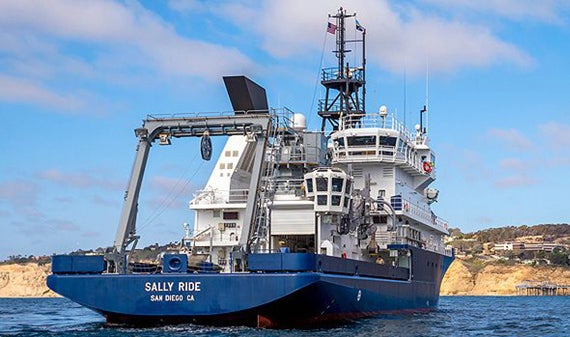KINGSTON, R.I., August, 9, 2018 — Scientists, post-doctoral researchers, technicians and graduate students from the University of Rhode Island are among 100 researchers from 30 institutions participating in a month-long expedition to study microscopic organisms that live deep in the ocean and play a critical role in removing carbon dioxide from Earth’s atmosphere.
The large-scale, multi-year campaign, EXport Processes in the Ocean from Remote Sensing (EXPORTS), is led by NASA with funding from the National Science Foundation. It is the first effort of its kind to study plankton, microscopic organisms, and their impact on Earth’s carbon cycle — important information for climate modeling. Team members also will examine the impact of phytoplankton on the optical properties of the ocean’s surface — how they absorb and scatter sunlight — which is fundamental to discerning the signals that satellites retrieve from space. The EXPORTS findings, combined with satellite data, will allow researchers to better understand what is happening deep in the oceans and the impacts on the carbon cycle.
Bethany Jenkins, professor of cell and molecular biology in the College of the Environment and Life Sciences, and Melissa Omand, assistant professor of oceanography at the Graduate School of Oceanography, shipped out of Seattle on August 9. Susanne Menden-Deuer and Tatiana Rynearson, professors of oceanography, are supporting the mission from land.
The scientists will sail 200 miles west of Seattle into the North Pacific Ocean on the research vessels Roger Revelle and Sally Ride to investigate the secret lives of plankton and the animals that eat them. They will deploy advanced underwater robotics and other instruments at ocean depths up to a half mile, where little or no sunlight penetrates. In these regions, referred to as the twilight zone, carbon produced by plankton can be confined in pockets and kept out of Earth’s atmosphere for decades, or even thousands of years.
“The continued exploration of the ocean, its ecosystems and their controls on the carbon cycle as observed with advanced technologies by EXPORTS will provide unprecedented views of Earth’s unseen world,” said Paula Bontempi, EXPORTS program scientist at NASA headquarters in Washington, D.C. “The science questions the team is tackling really push the frontier of what NASA can do in both remote and in situ optical ocean research. NASA’s goal is to link the biological and biogeochemical ocean processes to information from planned ocean-observing satellite missions, thus extrapolating the results from this mission to global scales.”
Phytoplankton, drifting, single-cell plant-like organisms, are of particular interest to researchers because they play a key role in Earth’s climate by removing heat-trapping carbon dioxide from the atmosphere through photosynthesis. Their abundance and high productivity make phytoplankton an ideal food source for small animals called zooplankton. Yet a detailed account of what becomes of that carbon — how much of it goes where within the Earth and for how long — has beset scientists for decades.
“If you have a million phytoplankton and zooplankton eat 500,000 of them, the phytoplankton can quickly bounce back to a million within one day,” said Rynearson. “Phytoplankton provide energy for the whole ecosystem because they’re able to replenish their populations rapidly.”
One objective of the research is to improve understanding of plankton through genetics. Rynearson and others will be involved in identifying various phytoplankton and zooplankton species by their DNA and determining which species are at the surface, which are sinking, and which are living in the deep ocean.
“Essentially, we’re trying to pick apart who’s there and what they’re doing and how much carbon is cycling through these different species,” Rynearson said. The genetic data will be linked to optical measurements, conducted as part of the on-site work, to help build optical proxies of critical ocean ecosystem and biogeochemical properties. Scientists will then further define and refine approaches to measure ocean ecosystem variables remotely, ultimately linking carbon export processes to satellite measurements.
Keep up with the expedition at oceanexports.org
https://earthobservatory.nasa.gov/blogs/
Or follow Rynearson’s updates at: https://web.uri.edu/rynearson-lab/blogs/
Follow EXPORTS on social media: @NASASocial
@NASAEarth
@NASAOcean
@NASAGoddard
@NASA

